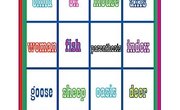Using the eight parts of speech once in one sentence is extremely tricky. If you are not thoroughly familiar with the eight parts of speech (noun, pronoun, verb, adjective, adverb, preposition, conjunction and interjection) and their functions, it is near impossible. However, it can be done: “Well, I left angrily because of several insults.” This sentence is parsed as follows: interjection-pronoun-verb-adverb-conjunction-preposition-adjective-noun.
Learn the eight parts of speech and their functions and how to identify them. Each part of speech serves a different purpose in a sentence. For example, each sentence requires a noun and a verb. You cannot determine if you have used all eight parts of speech only once if you do not know how to recognize them.
Differentiate between transitive and intransitive verbs. Transitive verbs perform an action on an object, such as “She baked the cake.” “Cake” is the object “bake” performs upon. An intransitive verb, such as in “She jumped,” does not require an object. The verb “jumped” does not perform upon anything and therefore does not require an object. If you are having trouble not incorporating more than one noun in a sentence, use an intransitive verb, which does not require a noun object.
Decide on an interjection to use first that makes sense with your sentence. Generally interjections are used with dialogue, and not in formal writing, so your sentence will sound the most natural if it is something somebody would say in a conversation.
Play around with your sentence until you get it right. Creating a sentence that contains all the parts of speech only once might take you a few tries.
Warning
Watch for prepositions that are actually functioning as adverbs. The sentence, “Wow, his monkeys really jump so high up” appears to use all eight parts of speech once. However, “so” is functioning like an adverb here, because it describes “high,” which is an adjective. So there is no preposition in the sentence.
Related Articles
References
- “Simon & Schuster Handbook for Writers;” Lynn Quitman Troyka, 2002
Warnings
- Watch for prepositions that are actually functioning as adverbs. The sentence, "Wow, his monkeys really jump so high up" appears to use all eight parts of speech once. However, "so" is functioning like an adverb here, because it describes "high," which is an adjective. So there is no preposition in the sentence.
Writer Bio
Nadine Smith has been writing since 2010. She teaches college writing and ESL courses and has several years experience tutoring all ages in English, ESL and literature. Nadine holds a Master of Arts in English language and literature from McMaster University in Ontario, Canada, where she led seminars as a teaching assistant.











